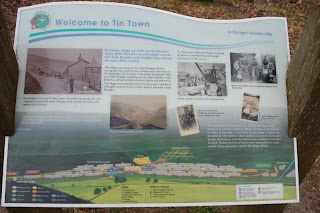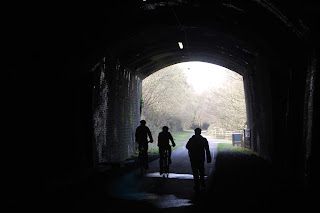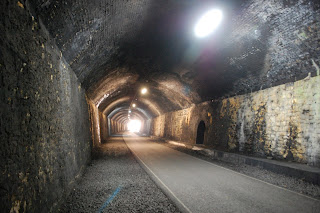When we woke up, the morning after our adventure to the reservoirs, we were very excited small bears. This because Polar had told us, the evening before, that we were going to visit a cave. She said that there are several caves open to the public around the Hope Valley and they are all different. She thought we would like Treak Cliff Cavern the best, but she wouldn't tell us why.
We wondered if other small bears lived there, or if it was in a pretty forest. Because we were so keen to visit, we had our hats and warm jumpers on long before Grizzly and Polar got back from breakfast.
As we drove along the Hope Valley, Polar told us she used to do lots of long walks here when she was a student, getting off at one of the little railways stations and walking along the ridges and through the fields to the next one. 'You can see the views from one of the walks, from Lose Hill to Mam Tor, on one of those funny Channel 4 links with the "4" as a metal man,' she said. 'The road ahead goes through Winnat's Pass, which is the only road out of this end of the valley, as the Mam Tor road collapsed, but we go a little way along it to get to the cave.
A nice man called Mr Sam led us all into the cave, warning everyone that the roof was very low to start with. Polar told us to tuck ourselves right down in the bear bag as she would have to stoop a lot. Hanley Bear didn't listen, as he was so eager to see where we were going, and he bumped his head on the rock.
'Ouch!' he shouted. 'I've got cave slime on my hat!'
'You're lucky it hasn't got on your fur,' I said. 'Or you would have to have a bath when we get home.'
'There are pretty-coloured crystals in the rocks!' cried Endon.
'That's what the miners used to dig out,' said Grizzly. 'It's a semi-precious stone they call Blue John.'
'What a funny name for a stone!' said Hanley Bear.
Mr Sam explained to everyone that it got the name because the French called it 'Bleu Jaune' because it is blue and yellow, which became 'Blue John'. It is very special because it is only found in the Peak District, where they still mine small amounts for making pretty things. There were two miners working in a cave we couldn't see during our visit.
'This would make a brilliant bear cave,' Endon said. 'To make it look nice, we could polish the Blue John in the walls until it was all shiny.'
'We would need to wear our jumpers all the time if we lived here,' I replied. 'It's pretty but, because it's all made of stone, it's very cold. Big wild bears could live in here but we would get very chilly. '
'There's a lot more to see yet, little bears,' said Polar. Just then, Mr Sam put all the lights out so we could see how dark it was. We couldn't even see our own paws held up in front of our noses. We were glad when the lights came on again.
Going up and down even more steps, we started to see stalactites and stalagmites. We knew what stalactites were, because we have seen them in canal tunnels, but we had never seen stalagmites (which appear to grow out of the ground) before.
A few of them were taller than us bears. There is one group called the Seven Dwarves (even though there are more than seven of them!)
In the last chamber, we found stalactites that were longer than us and 'flow stones', where the minerals that make the stalactites looked like frozen waterfalls. Endon wanted to climb them, but Polar kept him safely in the bear bag.
'Stalactites take hundreds of years to form but they are very fragile,' she explained. 'Just look, little bears - don't poke at things with your paws!'
We decided this must be a special, magic bear cave, which only very well-behaved small bears were allowed to visit. It was lovely to look at but, with all the water running down the walls and dripping off the ceiling to make the stalactites and flow-stones, it would have been too damp for us to live in or even for wild bears to use for hibernating - unless they were magic bears!
When we came out of the cave, we were even higher up the side of Mam Tor. Polar had been planning to take a photograph of us but instead we sheltered under Grizzly's umbrella and hurried down to get a nice cup of tea, to warm up.
We went home via Monsal Head, where our railway walk would have taken us if we had kept on through the tunnel, and stopped for more tea and some delicious cake at the Post Office in Hartington. Before we got home, there were more stormy showers, so we settled down for naps, dreaming about the magic bear cave and wondering what our next adventure might be.

































































